Unravelling the mystery of Orkney’s 77 whales: Experts reveal the devastating chain of events that could have caused Britain’s biggest mass stranding in a century
It is a tragic and heartbreaking sight: 77 dead whales lying in a row on a beach in Orkney.
It is the largest mass stranding in Britain in a century, with male whales measuring up to seven metres long, as well as females, calves and young.
It is thought that they suffocated from inhaling water from the rising tide or that their organs were crushed by their own weight.
But how could so many be stranded at once? And why were they driven to the coast?
MailOnline spoke to marine biologists and whale experts to unravel this devastating mystery on Sanday Island.
A tragic sight: MailOnline speaks to marine biologists and whale experts in an attempt to unravel this tragic mystery on the island of Sanday in Orkney, Scotland
According to experts, the 77 whales are pilot whales (Globicephala melas), a species found throughout the North Atlantic Ocean.
Pilot whales have close social bonds. If one member of a group gets into trouble, others often follow, resulting in mass strandings.
It is possible that one of the participants made a navigational error, became ill or became disoriented, causing him or her to sail too close to shore.
‘If one family member is sick or injured, the other family members stay with the animal,’ Dr Kevin Robinson, director of the Cetacean Research & Rescue Unit (CRRU), told MailOnline.
‘As a result, the entire group may tend to become stranded.
Because pilot whales are in the open sea, they may be unfamiliar with coastal environments such as tidal currents, sandbanks and bottleneck harbours.
“(They) can then be surprised by these physical anomalies if they are too close to shore,” Dr Robinson added.
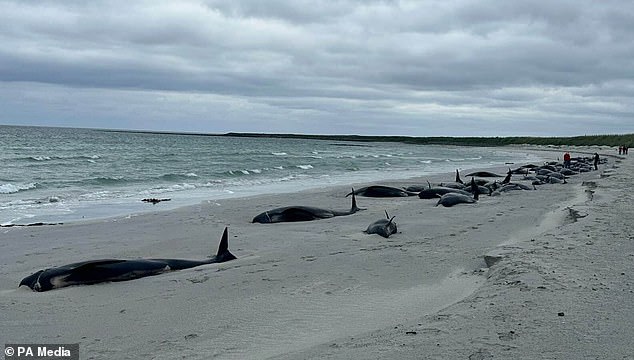
Long-finned pilot whales (Globicephala melas) are one of the most common species to strand in the UK
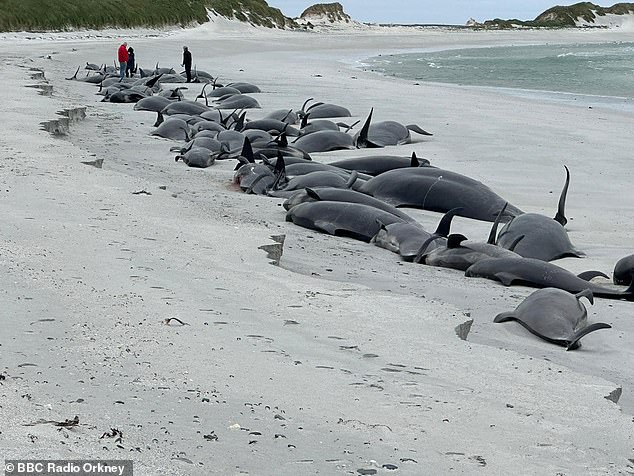
The mass strandings involve male whales up to seven metres long, as well as females, calves and young.
According to Ian Wiese, chairman of Geographe Marine Research in Western Australia, pilot whales are often the species involved in these types of events.
‘They are deep-sea whales and if they are close to shore it would suggest there is something wrong – probably with their navigation, because they shouldn’t be that close to shore,’ he told MailOnline.
‘There are many theories about why this happens, but we don’t really know.
“They are very social and form large groups. When an incident like this occurs, there are usually a lot of whales involved.”
Mr Wiese added: ‘Once they end up on the beach it’s usually a race against time to save them.
‘It has been found that the best approach is to wait until they can all be ‘relaunched’ at the same time. Otherwise they often come back and get stranded again.
‘However, their bodies cannot support the weight and their organs become damaged.’
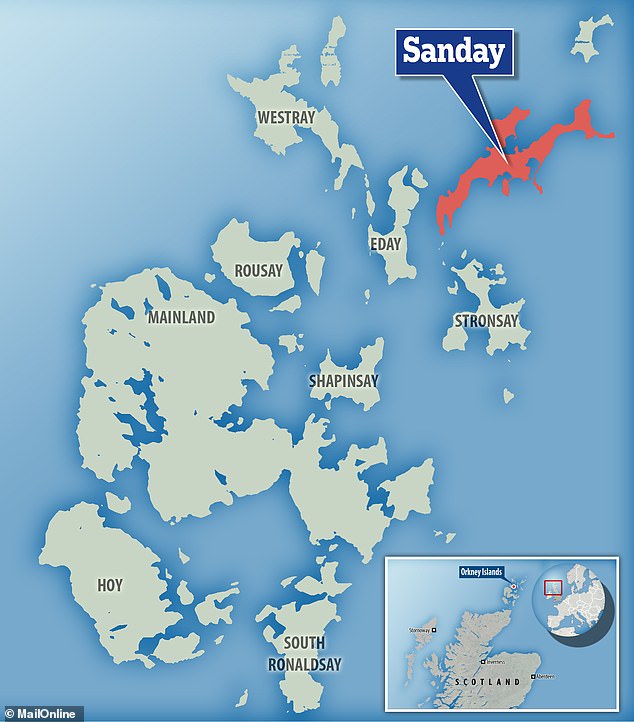
On 11 July 2024 at approximately 10:45am, British Divers Marine Life Rescue received a report of a mass stranding of long-finned pilot whales on the island of Sanday, Orkney
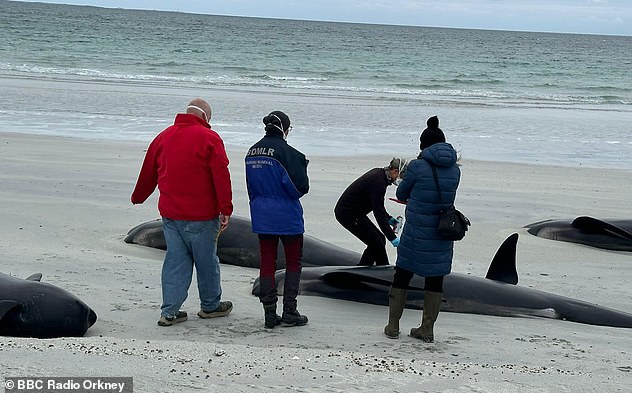
When they were discovered by a member of the public on July 10, 12 of them were still alive and struggling to breathe. However, these surviving 12 had to be euthanized when attempts to return them to the sea sadly failed, according to the British Divers Marine Life Rescue (BDMLR).
Like other whale species, pilot whales emit distinctive ‘clicks’ to detect objects via reflected sound waves – a process called echolocation.
Dr Chong Wei, a researcher at Curtin University’s Centre for Marine Science and Technology, said human noise pollution could disrupt this.
‘These whales rely on sound for all their vital life functions and are extremely sensitive to it,’ Dr Wei told MailOnline.
‘The frequencies of many man-made sound sources overlap with the hearing range of whales.
‘That intense noise can cause hearing loss and behavioral changes in these animals.’
Olaf Meynecke, a researcher at Griffith University’s Coastal and Marine Research Centre, agreed that human triggers could be a factor.
‘Once they get into shallow, sandy water they can’t orient themselves because they’re using very finely tuned sonar,’ he told MailOnline.
‘The sand absorbs the sonar and the shallow water prevents the sonar from traveling far enough to map the area.
‘Mass strandings of pilot whales have been occurring in such areas for some time, but we are now seeing an increase that can be attributed to increased stress, changes in environmental conditions, food availability and an increased likelihood of group leaders becoming ill.’
There is also speculation that the whales were driven to shore by orcas (‘killer whales’), but it could also be a combination of factors.
Dr Capri Beck, a bioacoustician at Geographe Marine Research, said: ‘Another (possibility) is that something has caused them to end up in shallow water, for example because they were hunting for prey, there has been an interruption in magnetic fields or there has been some other event that has startled them.
‘When these animals get close to shore, especially in shallow slopes, their sonar often doesn’t work as well and they’re not used to waves and currents.
“They can become disoriented and stranded.”
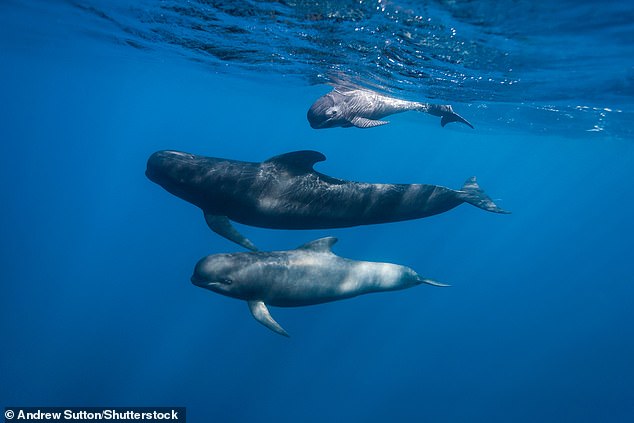
Pilot whales use a variety of ‘clicks’ to detect objects via reflected sound waves – a process called echolocation (archive photo)
When the 77 whales were discovered by a citizen on July 10, 12 of them were still alive and struggling to breathe.
But the 12 surviving animals had to be euthanised when attempts to return them to the sea sadly failed, according to the British Divers Marine Life Rescue (BDMLR).
“Regrettably, the remaining 12 pilot whales were euthanized due to their condition,” the BDMLR said in a statement.
It added that they ‘deteriorated from the many hours they had spent stranded on the beach, being crushed by their own weight and likely having inhaled water from the incoming tide’.
The Scottish Marine Animal Strandings Scheme plans to commence post-mortem examinations.
Almost a year ago, a similar incident involving pilot whales occurred on Lewis, another Scottish island west of the mainland, with at least 55 whales dying or being euthanised.
Earlier this year, a mass stranding also occurred in Western Australia.
